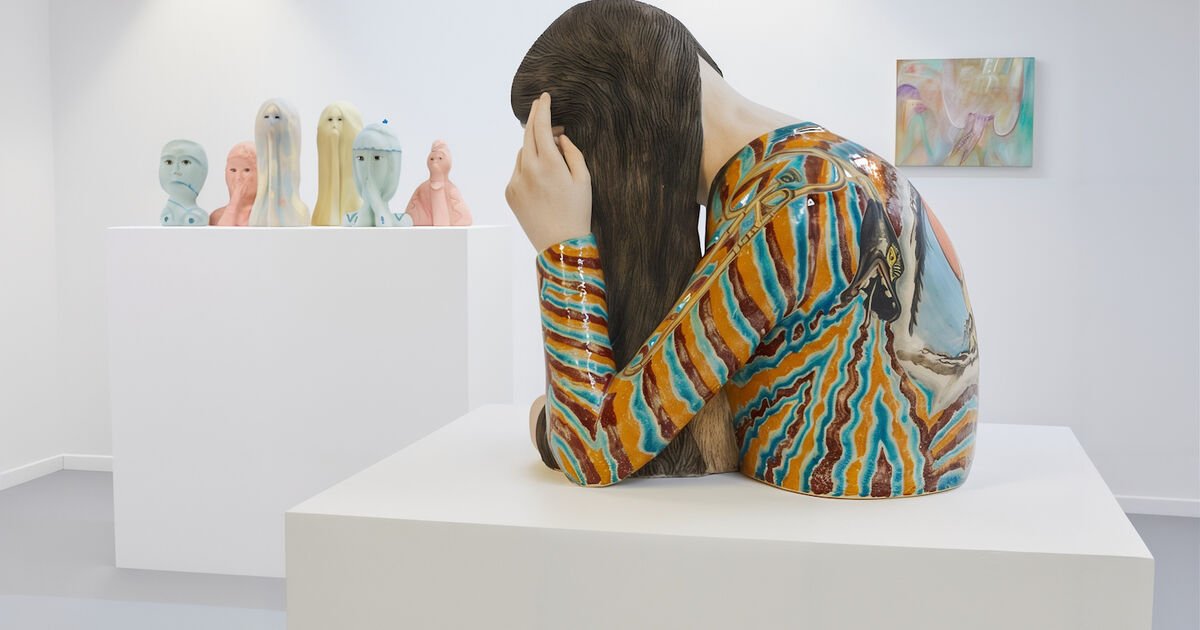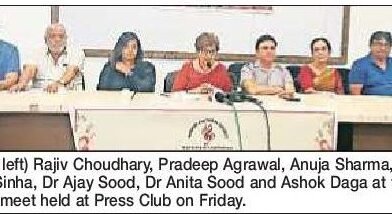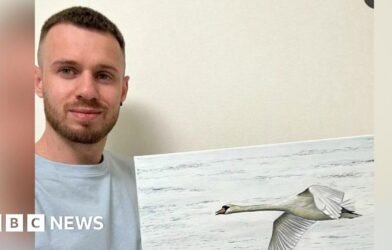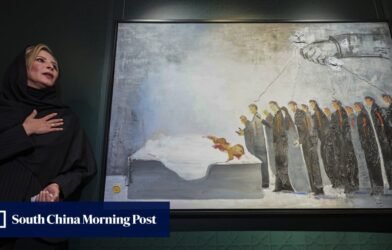Art Market
Sarah Moroz
Interior view of The Salon by NADA, 2024. Courtesy of The Salon by NADA.
Robert Zehnder, detail of Tree Line Belly 2, 2024. Courtesy of Mrs. Gallery.
If two heads are better than one, then The Salon by NADA and The Community is indeed a cut above: The American nonprofit is collaborating with the Paris-based collective to yield a fresh take on the alternative art fair in the French capital, featuring almost 50 galleries at 30 bis Rue de Paradis in the 10th arrondissement.
The fair, which opened its VIP preview yesterday, takes place in an increasingly crowded week for the Parisian art world: As well as the opening of Art Basel Paris, the city is home to a number of art fairs this week, from Paris Internationale to Asia Now. As the founders of the fair explain, the decision to launch in Paris was borne of member demand.
“We periodically ask our members where they’d like to see NADA doing fairs, and doing a fair in Paris was very high on the list,” NADA executive director Heather Hubbs noted. Founded in 2002, New Art Dealers Alliance (NADA) is a trade association and also hosts art fairs in New York and Miami. NADA has primarily remained an American fair, excepting its presence within Art Cologne from 2013 to 2016, and Warsaw earlier this year. Hubbs hopes that by growing a European presence, NADA will entice more galleries in other territories.
Interior view of The Salon by NADA, 2024. Courtesy of The Salon by NADA.
“It’s a new way of doing a fair—most people don’t organize fairs in partnership like this…it just creates a different ecosystem in an art fair setting,” she said. “Being an organization based in the United States, we knew that we would want to work with someone locally. The Community’s ethos and mission was very much aligned with NADA.”
The Community, founded in 2016 in Paris, is a versatile and multihyphenate organization. It began with a small headquarters in the 10th arrondissement, not very far from where The Salon is currently hosted. The collective moved to Pantin, just outside of central Paris, where they curate projects in a gallery and al fresco green space.
The Community previously spearheaded the fair Salon de Normandy, held in 2019 and 2020, in the 1st arrondissement on rue de l’Echelle. “There was a need to have a different way of doing an art fair—even though we didn’t consider it really an art fair in the beginning,” said the Community’s founder and director Tuukka Laurila. Still, the events were attended by all the different players of the art world: collectors, institutional representatives, and people from auction houses.
Interior view of The Salon by NADA, 2024. Courtesy of The Salon by NADA.
“It was a validation that what we wanted to propose wasn’t only serving the audience that we were already serving, but the idea was bigger than [that],” Laurila noted. “It showed us that there’s a way to start from a grassroots level—even in France, where it’s not always easy, because there are certain standards, and we have a beautiful, long history here. But we realized, ‘Okay, we can do this on the level that is appreciated by the exactly same audiences that go to the bigger affairs or the biggest institutional contexts.’”
Hubbs and Laurila met in Los Angeles in 2023 around the Felix Art Fair, by way of a common friend. “We’re completely different operators in the art world, but we’re working towards the same goals, which is to promote new and emerging art and promote small and medium-sized galleries—but also very open to all other forms,” said Laurila.
Interior view of The Salon by NADA, 2024. Courtesy of The Salon by NADA.
Their collaboration is The Salon, an invitational fair, which congregates NADA’s membership of commercial galleries among The Community’s network of nonprofit arts organizations, mixed throughout without demarcation. The Paris iteration is a smaller scale relative to NADA’s fairs in New York (about 100 galleries) and Miami (about 130), featuring almost 50 exhibitors. This reduced remit was, for one, to “give everybody more attention” and to remain “realistic,” Hubbs clarified. Of the participants, around 20 have never done a NADA fair. “We feel 50 is a good number that you can go through in a couple of hours and without exhaustion. It’s intimate, but not in a way that is architecturally intimate,” Laurila said.
Across the five-floor space, one-third are nonprofits and two-thirds are commercial galleries. Exhibitors span from more established names such as Tokyo’s Yutaka Kikutake Gallery to newer names such as Margot Samel, cadet capela, and Patel Brown.
Galleries at the forefront
Interior view of 30 bis Rue de Paradis. Courtesy of The Salon by NADA.
The Salon is located in a striking venue that seems tailored to its new endeavor in the luminous glass-walled former office/training center for France’s state-owned railroad system (SNCF – Société Nationale des Chemins de Fer Français), recessed behind rue de Paradis. Aaron Harbour of the gallery Et al., which is doing a two-person Californian artist–based show of Laura Rokas and Deondre Davis, and has regularly participated in NADA fairs since 2012, described the space as “more of an adventure than a typical art fair.”
“The idea is that it’s not just booths next to each other, but it’s also this experience-based thinking, where people can come to the fair and not only see the galleries, but also see a performance, or listen to a concert, or come back the next day for the book fair,” noted Laurila. “We really have these kinds of access points for different audiences.” The collectors are, of course, very important for the first day during the preview, and they will have access to artists who have not necessarily had a presence in another fair recently in Europe—or at least in France. But in the days thereafter, the idea is to garner a local audience that doesn’t go to art fairs systematically.
Installation view of Embajada’s booth at The Salon by NADA, 2024. Courtesy of Embajada.
Janina Zais, Life Is Pain Au Chocolat, 2022. Courtesy of Goswell Road.
An eagerness for galleries and nonprofits to have a presence in Paris was unilaterally echoed throughout the fair. Christopher Rivera of embajada, which features Puerto Rican artists, has been part of NADA since just after he opened his gallery in 2015. He has participated in ARCO Madrid, given the natural Spanish-language connection, but was excited to be in Paris. “I feel every time I’m doing a fair, I’m representing the country, because we’re a colony still,” Rivera said. He is showing horror-trope paintings by Tania Cruz, compositions of seashells by Chaveli Sifre, laser-engraved mirrors by Gabriella Torres-Ferrer, and crafted clay vessels by Jorge González; the prices range from €4,000–€16,000 ($4,338–$17,352).
Nonprofit space GOSWELL ROAD, which is based in Paris—“we’re not very far from here, actually,” noted British-born co-founder Anthony Stephinson—had previously done three editions of Paris Internationale, a fair that is also running this week and dedicated to emerging art and galleries. “We knew the people from The Community for a long time because they used to be based near us. So we had a kind of neighbor relationship already,” he said: “I think it is important that there’s space for other things and other international initiatives to be part of the city.” Moreover, he feels the art world “has a bit more faith in [Paris] as a cultural entity” since he opened in 2016. GOSWELL ROAD is hosting a solo booth—its signature approach—featuring Janina Zais, who catalogs her body-painting and makeup practices; here, she is also showing two suspended stenciled hair pieces, which Stephison describes as “floating Cousin It planets.”
Janina Zais, installation view in Goswell Road’s booth at The Salon by NADA, 2024. Courtesy of Goswell Road.
New York–based Mrs. Gallery, previously present at NADA Miami and New York, is showing, within a group context, canvases by Robert Zehnder and Alexandra Barth, the latter of whose paintings reveal “the memory of details in a particular room.” Paris is a compelling new constellation of the fair, for co-founder and director Sara Maria Salamone. “It feels like there’s a good, strong base of galleries and dealers here. Because it’s sort of a smaller city, it feels very concentrated, and it feels wonderful to be able to sit in that rich history that we just don’t have in America. You can go to the Musée de Cluny and see the unicorn tapestries, but you can also go to the art fair and see the most contemporary art in the whole entire world. It just feels like Paris has welcomed this exuberance.”
London-based Night Café is doing its first fair ever, having existed only for a year when it received the invite, with its founder Maribelle Bierens noting: “I feel like there’s something really special happening in Paris right now—and it’s also personally full circle because Night Café is actually a reference to café culture in Paris.” She’s showing, in a group booth, sculptural works by Rebecca K Halliwell Sutton—whose show at the London gallery just concluded—and paintings by Marco Bizzarri based on photographs from very remote areas in Chile. The prices range from €1,000–€3,500 ($1,084–$3,795).
Installation view of Mrs. Gallery’s booth at The Salon by NADA Paris, 2024. Courtesy of Mrs. Gallery.
The Fall River Museum of Contemporary Art (FRMOCA) is a nonprofit based in the industrial Fall River, Massachusetts, working a lot with the youth in that city. “We talk about our project being this connector,” said FRMOCA’s Brittni Ann Harvey, who notes that despite being “scrappy,” “for the amount of money that we’ve been able to fundraise, we’ve created so much value for the city.”
For Harvey, NADA bridges the gap between local and global: “It’s nice to feel a sense of camaraderie. Where we’re located, it’s a very unique offering for that space, and so to engage with other nonprofits…we’ve had a lot of conversations and we realized we have a lot of similarities that we’re grappling with.” The booth features a group show including self-taught artist and software engineer Jake Tobin’s intricate colored pencil drawings, Anna Solal’s sculptures of old iPhone screens, and Kendall Rivera-Lane’s medical illustrations, preceding her medical school training in the fall.
An ideal home in Paris
Installation view of Patel Brown’s booth at The Salon by NADA, 2024. Courtesy of Patel Brown.
Paris as a locus is changing what it offers, explained The Community’s Laurila. “We have such a rich, rich history here that the point is not to change that, and not to neglect that either, but I think there’s more room for more avant-garde thinking and current ways of doing things,” he stated. “I think also there’s this open-mindedness, where people are kind of thirsty for different approaches—maybe not at large, but if you look at the people that go to openings.” Ultimately, he noted, “It feels really good to be in Paris.”
Moreover, there’s a sense in the city that there’s room for everyone. “We are down the road from Paris Internationale, and we are, of course, good friends with them. The idea is that we do something that is complementary; the idea is not to compete. It’s really that the audience has even more to see and discover in that time of Paris art week,” Laurila said. “It’s not that [the fair] tries to be different, but it’s different because of our interest and our contacts and our ways of seeing what an experience means.”









